check engine AUDI Q3 2018 User Guide
[x] Cancel search | Manufacturer: AUDI, Model Year: 2018, Model line: Q3, Model: AUDI Q3 2018Pages: 230, PDF Size: 57.03 MB
Page 157 of 230
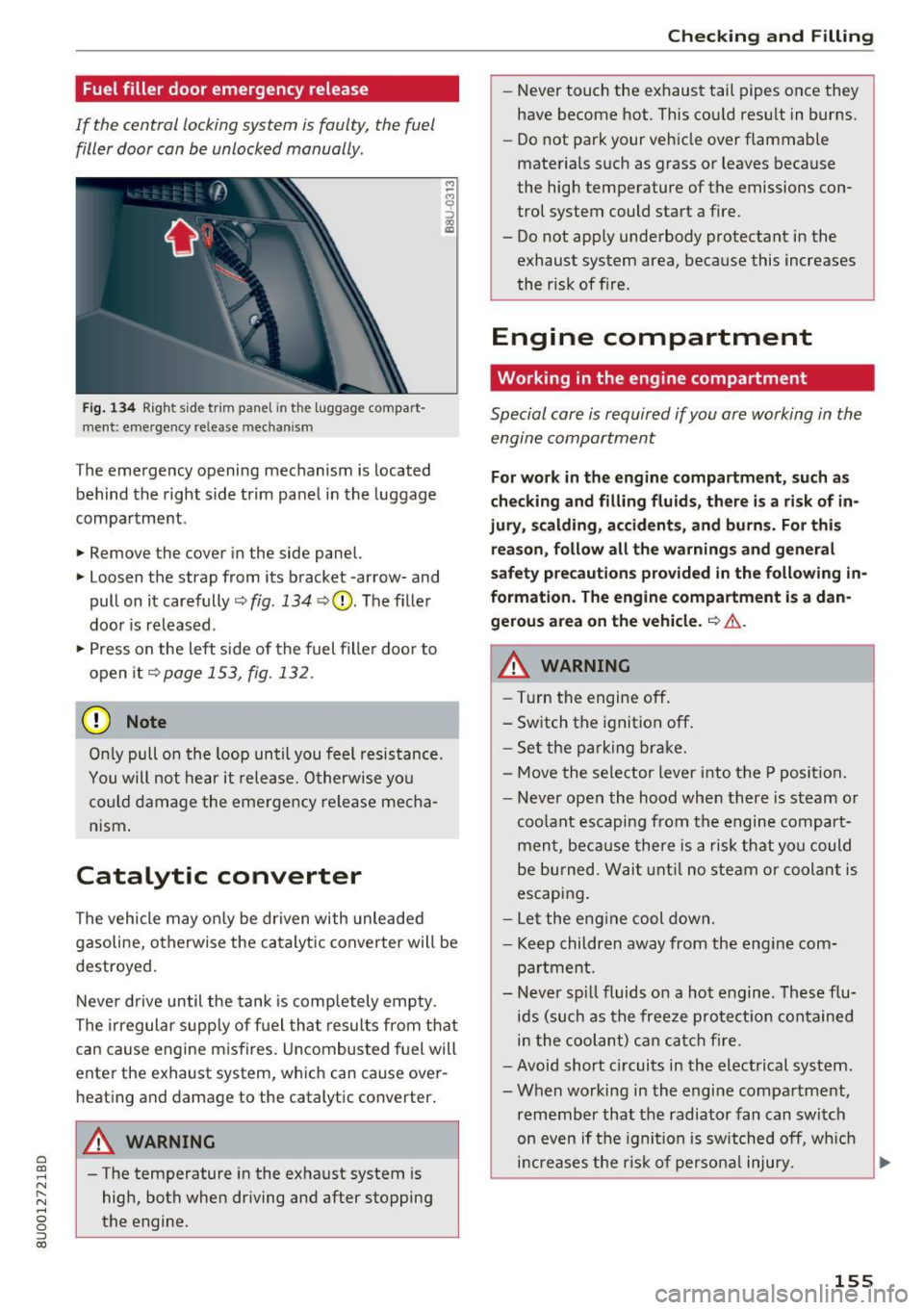
a
co
...... N r--. N .... 0 0 ::, co
Fuel filler door emergency release
If the central locking system is faulty, the fuel filler door can be unlocked manually.
Fi g. 134 Right si de tr im j:>ane l in the luggage compart
ment: emergen cy release mechani sm
The emergency opening mechanism is located
behind the right side trim panel in the luggage
compa rtme nt.
• Remove the cover in the side panel.
• Loosen the strap from its bracket -arrow- and
pull on it carefully<=:>
fig. 134 c:>(D . The filler
doo r is released .
• Press on the lef t side of the fuel fille r doo r to
open it
<=:> page 153, fig. 132 .
(D Note
Onl y pull o n the loop until you feel resi stance.
You will not he ar it relea se. O therwise yo u
co uld d amage the eme rge ncy re lea se me ch a
nism .
Catalytic converter
The vehicle may o nly be dr iven with unleaded
gasoline, otherwise the catalyt ic converter will be
destroyed .
N ever d rive until the tank is comp letely e mpty .
The irregular supply of f uel th at resul ts from that
can cause engine m isfires. Uncombus ted f uel will
enter the exhaust system, wh ic h can cau se ove r
heat ing and damage to the catalyt ic converter .
A WARNING
-The temperature in the ex ha ust system is
high, both when dr iving and after stopping
the engine.
-
Checking and Filling
- Never touch the exhaust tail pipes o nce they
have become hot . This cou ld resu lt in burns.
- Do not par k your vehicle over flammable
mate ria ls s uch as grass or leaves because
the high temperature of the emissions con
trol system could start a fire.
- Do not app ly unde rbody protectant in the
exhaust system area, because this increases
the risk of fire.
Engine compartment
' Working in the engine compartment
Special care is required if you are working in the
engine compartmen t
For work in the engine compartment, such as
checking and fill ing fluids, there is a risk of in
jury, scalding, accident s, and burns . For thi s
reason, follow all the warnings and general
s afety pre caution s provided in the following in
formation. The engine compartment is a dan
gerous a rea on the vehicle .
<=:> .&.
A WARNING
-Turn the engine off .
- Sw itch th e ignition off .
- Se t the p arking brak e.
- M ove the selec tor lever i nto the P position.
- Never open the hood whe n th ere is steam o r
coo lant escaping from the engine comp art
men t, bec ause there is a risk that yo u could
be burned. Wai t until no s te a m o r coolan t is
escaping .
- Le t t he eng ine cool down.
- Keep children away from th e eng in e com-
p ar tme nt.
- N ever sp ill fluid s on a ho t engine . These flu
i d s (su ch as the free ze p ro te ct ion contained
in the coolant) c an catch fi re.
- Avoid short circui ts in th e electrical system.
- When working in the engine compartment,
remember that the radiator fan can swi tch
o n even if t he igni tion i s sw itched off, w hich
i n cre a ses the r is k of person al injury.
~
155
Page 158 of 230
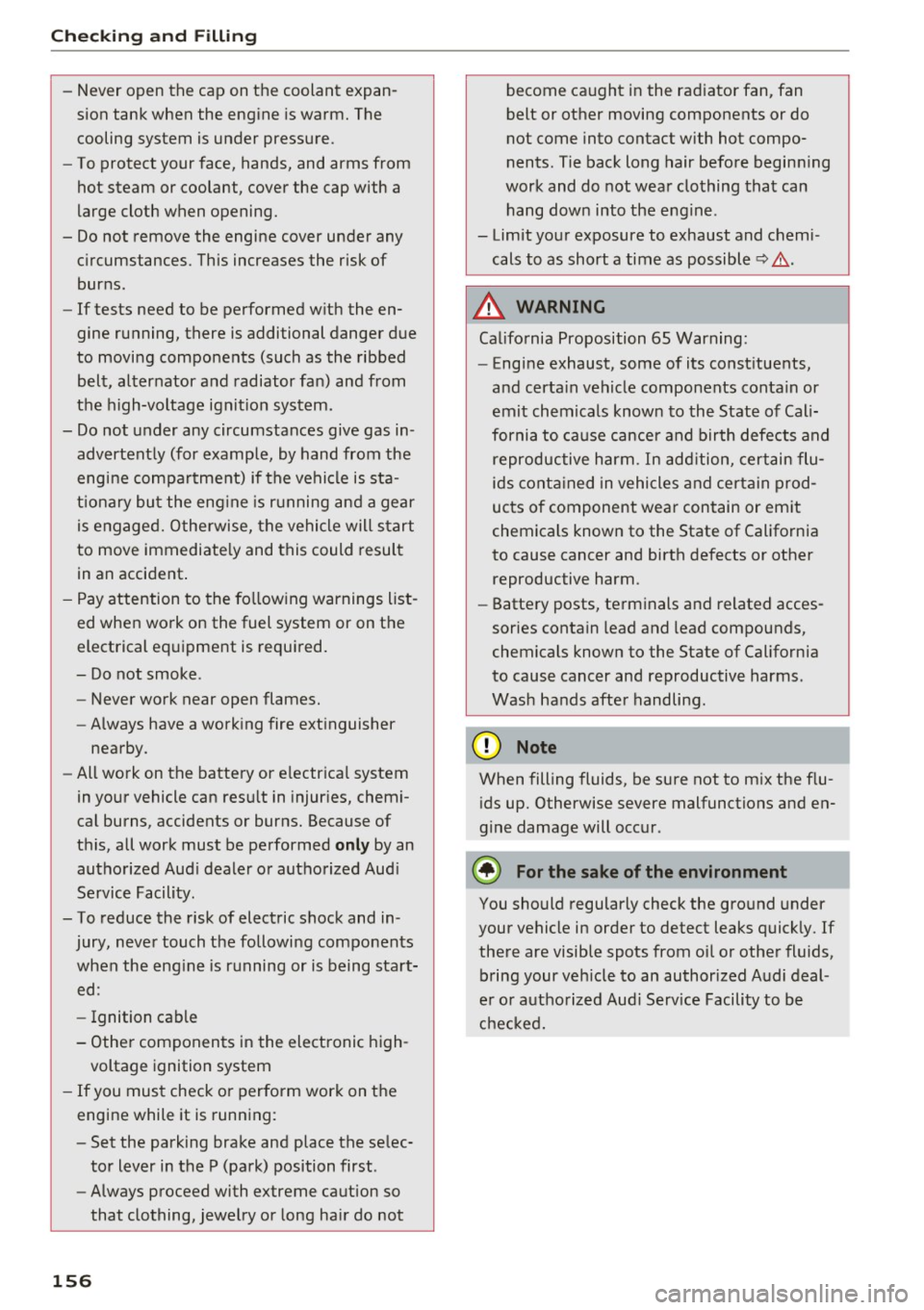
Checking and Filling
-Never open the cap on the coolant expan
sion tank when the engine is warm. The
cooling system is under pressure.
- To protect your face, hands, and arms from
hot steam or coolant, cover the cap with a
large cloth when opening.
- Do not remove the engine cover under any circumstances. This increases the risk of
burns.
- If tests need to be performed with the en
gine running, there is additional danger due
to moving components (such as the ribbed belt, alternator and radiator fan) and from
the high-voltage ignition system.
- Do not under any circumstances give gas in
advertently (for example, by hand from the
engine compartment) if the vehicle is sta
tionary but the engine is running and a gear
is engaged. Otherwise, the vehicle will start
to move immediately and this could result
in an accident.
- Pay attention to the following warnings list
ed when work on the fuel system or on the
electrical equipment is required.
- Do not smoke .
- Never work near open flames.
- Always have a working fire extinguisher
nearby.
- All work on the battery or electrical system
in your vehicle can result in injuries, chemi
cal burns, accidents or burns. Because of
this, all work must be performed
only by an
authorized Audi dealer or authorized Audi
Service Facility.
- To reduce the risk of electric shock and in
jury, never touch the following components when the engine is running or is being start
ed:
- Ignition cable
- Other components in the electronic high-
voltage ignition system
- If you must check or perform work on the
engine while it is running:
- Set the parking brake and place the selec
tor lever in the P (park) position first .
- Always proceed with extreme caution so
that clothing, jewelry or long hair do not
156
become caught in the radiator fan, fan
belt or other moving components or do
not come into contact with hot compo
nents. Tie back long hair before beginning
work and do not wear clothing that can
hang down into the engine .
- Limit your exposure to exhaust and chemi cals to as short a time as possible
¢ &, .
A WARNING
California Proposition 65 Warning:
- Engi ne exhaust, some of its constituents,
and certain vehicle components contain or
emit chemicals known to the State of Cali
fornia to cause cancer and birth defects and
reproductive harm . In addition, certain flu
ids contained in vehicles and certain prod
ucts of component wear contain or emit
chemicals known to the State of California
to cause cancer and birth defects or other reproductive harm .
- Battery posts, terminals and related acces
sories contain lead and lead compounds,
chemicals known to the State of California
to cause cancer and reproductive harms.
Wash hands after handling.
@ Note
When filling fluids, be sure not to mix the flu
ids up. Otherwise severe malfunctions and en
gine damage will occur .
@ For the sake of the environment
You should regularly check the ground under
your vehicle in order to detect leaks quickly. If there are visible spots from oil or other fluids,
bring your vehicle to an authorized Audi deal
er or authorized Audi Service Facility to be
checked.
Page 159 of 230
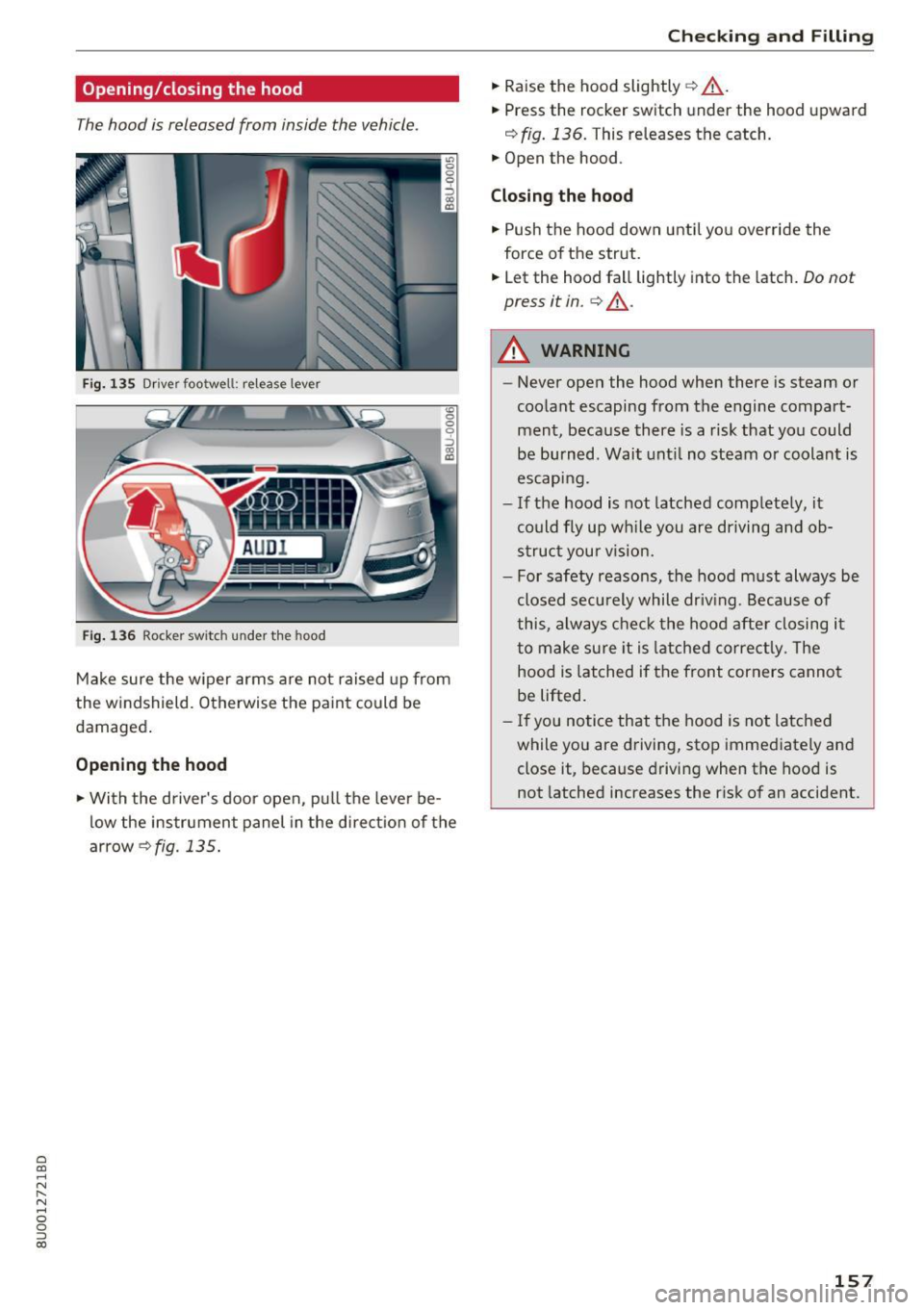
a
co
,....,
N r--. N
'"' 0 0 ::, co
Opening/closing the hood
The hood is released from inside the vehicle.
Fig. 135 Driver footwell: release lever
Fig. 136 Rocker switch under the hood
"' 0 0
0
=i
~
Make sure the wiper arms are not raised up from
the windshield. Otherwise the paint could be
damaged.
Opening the hood
.. With the driver's door open, pull the lever be
low the instrument panel in the direction of the
arrow¢fig.135.
Checking and Filling
.. Raise the hood slightly¢,& .
.. Press the rocker switch under the hood upward
¢fig. 136. This releases the catch .
.. Open the hood.
Closing the hood
.. Push the hood down until you override the
force of the strut .
.. Let the hood fall lightly into the latch.
Do not
press it in.
c> ,&.
A WARNING
-
-Never open the hood when there is steam or
coolant escaping from the engine compart
ment, because there is a risk that you could
be burned. Wait until no steam or coolant is
escaping.
- If the hood is not latched completely, it
could fly up while you are driving and ob
struct your vision.
- For safety reasons, the hood must always be
closed securely while driving. Because of
this, always check the hood after closing it
to make sure it is latched correctly. The
hood is latched if the front corners cannot
be lifted.
- If you notice that the hood is not latched
while you are driving, stop immediately and
close it, because dr iving when the hood is
not latched increases the risk of an accident .
157
Page 160 of 230
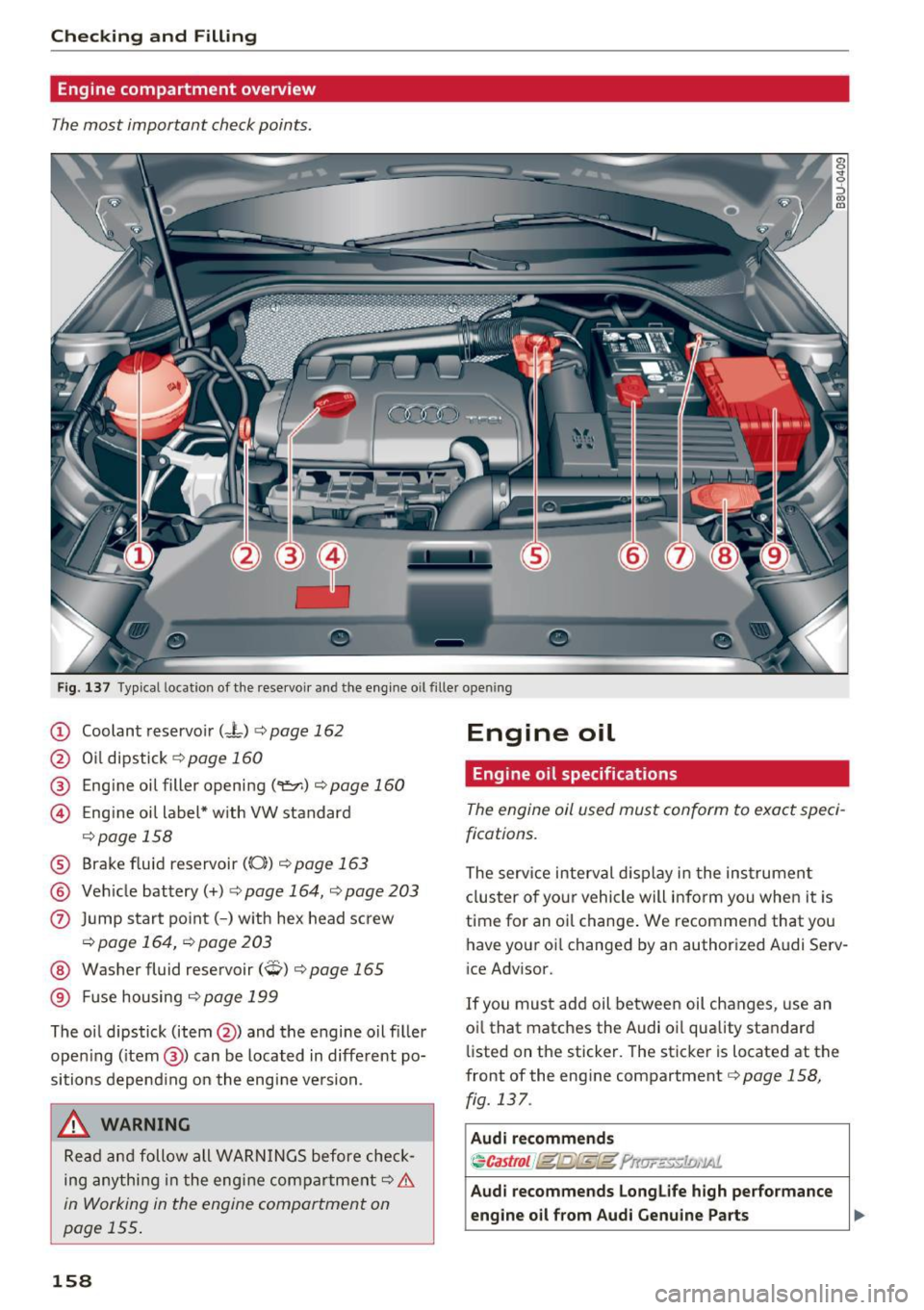
Checking and Filling
Engine compartment overview
The most important check points.
Fig. 137 Typical location of the rese rvoir and the engine o il fil le r open ing
(D Coolant reservoir ( - L) ¢ page 162
@ Oil dipstick ¢ page 160
® Engine oil filler opening ('t:::r.) ¢page 160
© Eng ine oil label* w ith VW standard
evpage 158
® Brake f luid reservoir ((0)) ¢ page 163
® Vehicle battery(+) ¢ page 164, evpage 203
(?) Jump start point( -) w ith hex head screw
ev page 164, ev page 203
@ Washer fluid reservoir (O) ev page 165
® Fuse housing c:::> page 199
The oil dipstick (item @) and the engine oil fi ller
open ing (item @) can be located in different po
sitions depend ing on the engine version.
_& WARNING
Read and follow all WARN INGS before check
ing anything i n the engi ne compa rtment¢ &.
in Working in the engine compartment on
page 155 .
158
Engine oil
Engine oil specifications
The engine oil used must conform to exact speci
fications.
The serv ice interval d isplay in the inst rumen t
cluster of your vehicle will inform you when it is
time for an o il change . We recommend that you
have your oi l changed by a n authorized Audi Se rv
i ce Advisor.
If you must add oil betwee n oil changes, use an
oi l that matches the Audi oil quality standard
li sted on the sticker. The sticker is located at the
front of the eng ine compartment ¢
page 158,
fig. 137 .
Audi re commend s
~Castrol /fg/j;Sf.g;fg f'r
eng ine oil from Aud i Genuine Pa rt s
liJI,
Page 161 of 230
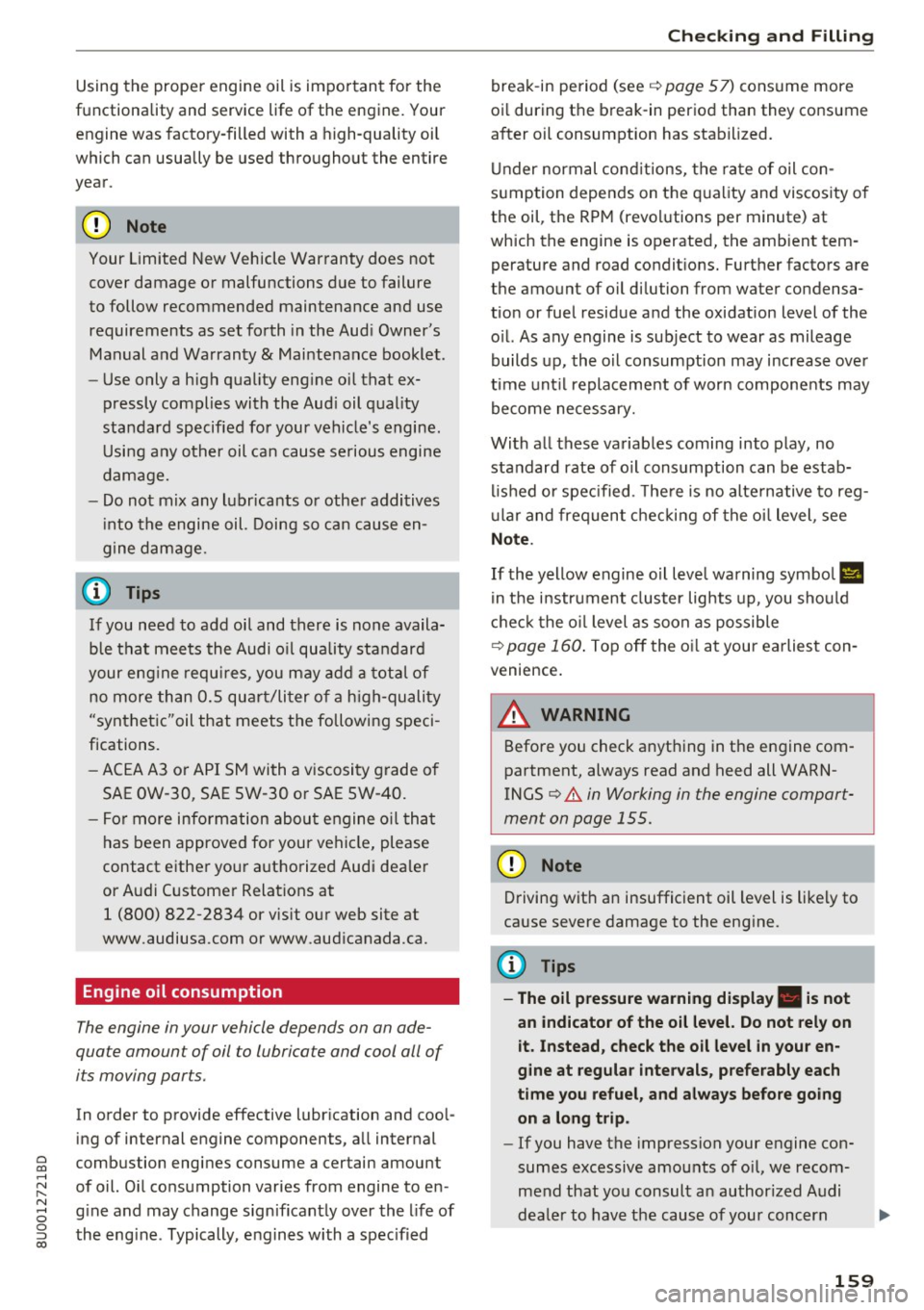
0 co ......
"' ,....
"' ...... 0 0 :::,
00
Using the prope r engine oil is important for the
functionality and s ervice life of the engine. Your
engine was factory-filled with a high -quality oil
which can usually be used throughout the entire
year .
Note
Your Limited New Vehicle Warranty does not
cover damage or malfunctions due to failure
to follow recommended maintenance and use
requirements as set forth in the Audi Owner's Manual and Warranty & Maintenance booklet .
- Use only a high quality engine oil that ex-
pressly complies with the Aud i oil quality
standard specified for your vehicle's engine.
Using any o ther oil can cause serious engine
damage.
- Do not mix any lubricants o r other additives
into the engine oil. Doing so can cause en
gine damage.
@ Tips
If you need to add oil and there is none availa
ble that meets the Audi o il quality standard
your eng ine requ ires, you may add a total of
no more than 0 .5 quart/li ter of a h igh-quality
"synthet ic"oil that meets the following speci
fications.
- ACEA A3 or API SM with a v iscosity grade o f
SAE OW-30, SAE SW -30 or SAE SW-40.
- Fo r more information abou t engine o il t ha t
has been approved for your vehicle, please
contact either your authorized Audi dea ler
or Audi Custome r Relat ions at
1 (800) 822-2834 or visit our web site at
www .audiusa.com or www .aud icanada .ca.
Engine oil consumption
T he engine in your vehicle depends on an ade
qua te amoun t of oil to lubricate and cool all of
i t s moving par ts.
In order to provide effective lub rication and coo l
ing of in te rnal engine components, a ll internal
combustion engines consume a cer tain amount
of oil. Oil consumption varies from engine to en
g ine and may change sign ificantly over the life of
the eng ine . Typically, eng ines with a spec ified
Ch eck ing and Filling
break-in period (see ¢ page 57) consume more
oi l during th e break-in period than they consume
after oil consumption has stabilized.
Under normal cond itions, the rate of oil con
sumption depends on the q uality and viscos ity o f
the oil , the RPM (revolutions per minut e) at
which the engine is operated, the amb ient tem
perature and road condit ions. Further factors are
the amount of oil dilution from w ater condensa
tion or fuel resid ue and the oxidation level of the
o il. As any engine is subject to wear as mileage
builds up, the oi l consumption may increase ove r
t ime unt il repla cement of worn components may
become necessary.
With al l these variables coming into play, no
standard rate of o il consumption can be estab
l ished or spec ified . T he re is no alte rnative to reg
u la r and fre quent chec king of the o il level , see
Note .
If the yellow engine oil level warning symbo l II
in the instrument cluster lights up , you sho uld
check the o il level as soon as possible
¢ page 160. Top off the o il at your earliest con
venience.
A WARNING
Before you check anything in the engine com
partment, always read and heed all WARN
INGS¢ .&.
in Working in the engine compart
ment on page 155.
(D Note
D riving wit h an insufficient oil level is likely to
cause severe damage to the engine .
(D Tips
- The oil pressure warn ing display. i s not
an indicato r of the o il le vel. Do not rely on
it . Instead, check the oil level in your en
gine at regular intervals , pre fe rabl y each
time you refuel, and alw ays befo re go ing
on a long trip .
-If you have the impression your engine con
sumes excessive amounts of oi l, we recom
mend that you consult an author ized Audi
dea ler to have the cause of your concern
159
Page 162 of 230
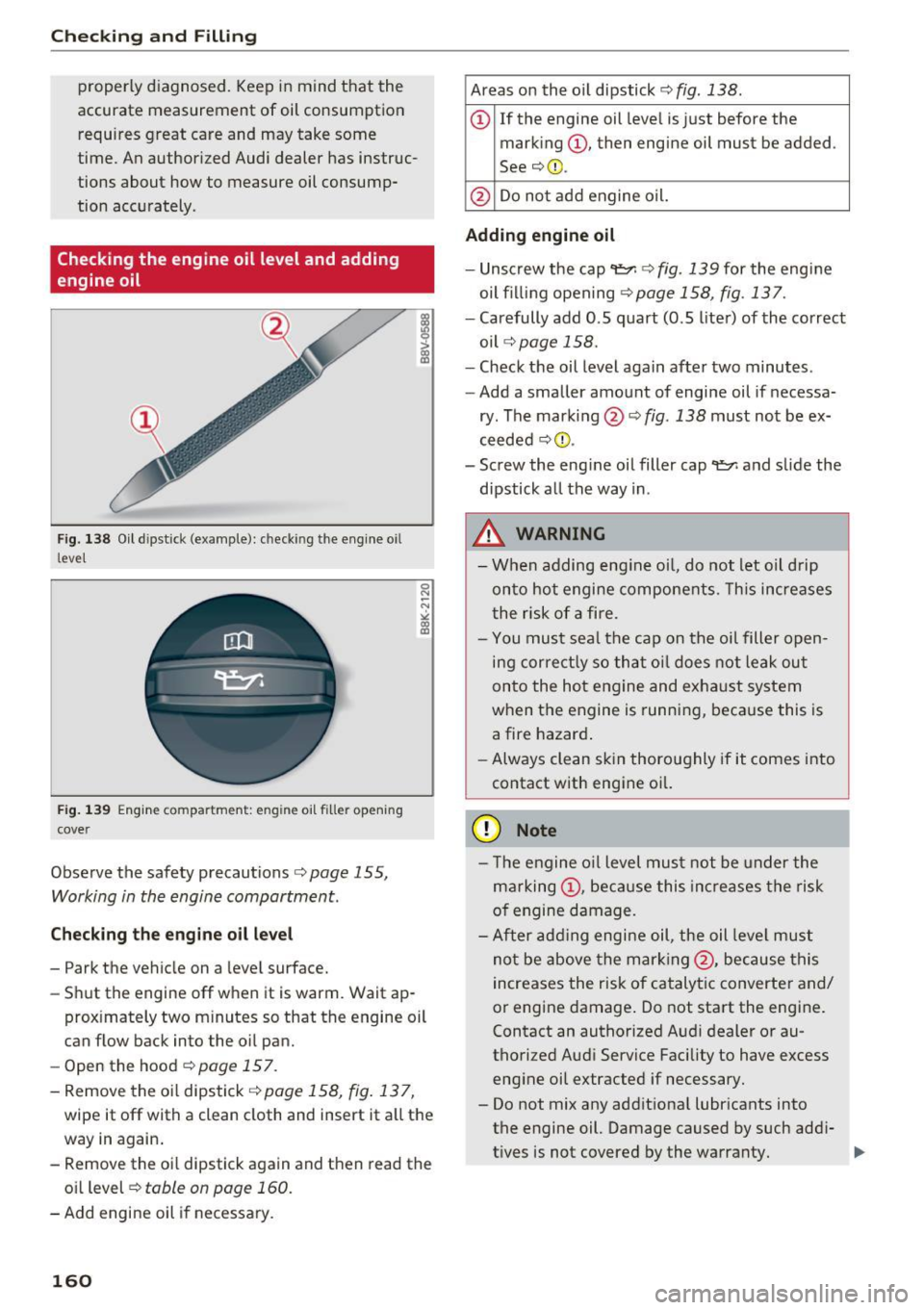
Checking and Filling
properly diagnosed. Keep in mind that the
accurate measurement of oil consumption requires great care and may take some
time. An author ized Audi dealer has instruc
tions about how to measure oil consump
tion accu rately.
Checking the engine oil level and adding
engine oil
F ig. 138 Oil d ipstick (example): c hecki ng the engine oi l
level
F ig. 139 Engine compartment: eng ine o il filler opening
cove r
Observe the safety precautions c:> page 155,
Working in the engine compartment .
Checking the engine oil level
- Park the vehicle on a level surface.
- Shut the engine
off when it is warm. Wait ap-
0 N
-N ~ a, (D
prox imately two m inutes so that the engine oil
can flow back into the oil pan.
- Open the hood
c:> page 157.
-Remove the oi l dipstick <=> page 158, fig . 137,
wipe it off with a clean cloth and insert it all the
way in again.
- Remove the oil dipstick again and then read the
oil level
c:> table on page 160.
-Add engine oil if necessary.
160
Areas on the o il dipstick c::> fig. 138.
(D If the engine oil leve l is just before the
mark ing
(D , then engine oil must be added .
See
c:> @ .
@ Do no
t add engine oil.
Adding engine oil
- Unscrew the cap
't=:rl c:> fig. 139 for the engi ne
oil fil ling open ing
c:>page 158, fig. 137.
- Carefully add 0 .5 quart (0.5 lite r) of the correct
oil
<=> page 158.
-Check the oil level again after two minutes .
- Add a smaller amount of engine oil if necessa-
ry . The mark ing @ c:>
fig. 138 must not be ex
ceeded c:>Cl) .
- Screw the eng ine oil filler cap
't=:rl and slide the
dipstick all the way in .
.&, WARNING
-When adding eng ine oi l, do not let o il d rip
on to hot engine components. Th is increases
t he risk of a fire.
- You must sea l the cap on the oi l filler open
ing correct ly so that oi l does not leak ou t
onto the hot engine and exha ust system
when the engine is running, beca use this is
a fire hazard .
- Always clean skin thoro ughly if it comes into
contact with engine oi l.
(D Note
- The engine o il level mus t not be under the
marking
(D , because this increases the risk
of engine damage .
- After add ing engi ne oil, the oil leve l must
not be above the mar king @, because this
increases the risk of catalytic converte r and/
or engine damage . Do not start the engine.
Contact an authorized A udi dealer or au
thorized Aud i Service Facility to have excess
engine oil extracted if necessary.
- Do not mix any addit iona l lubr icants into
the engine oil. Damage caused by such addi-
t ives is not covered by the warranty. .,_
Page 163 of 230
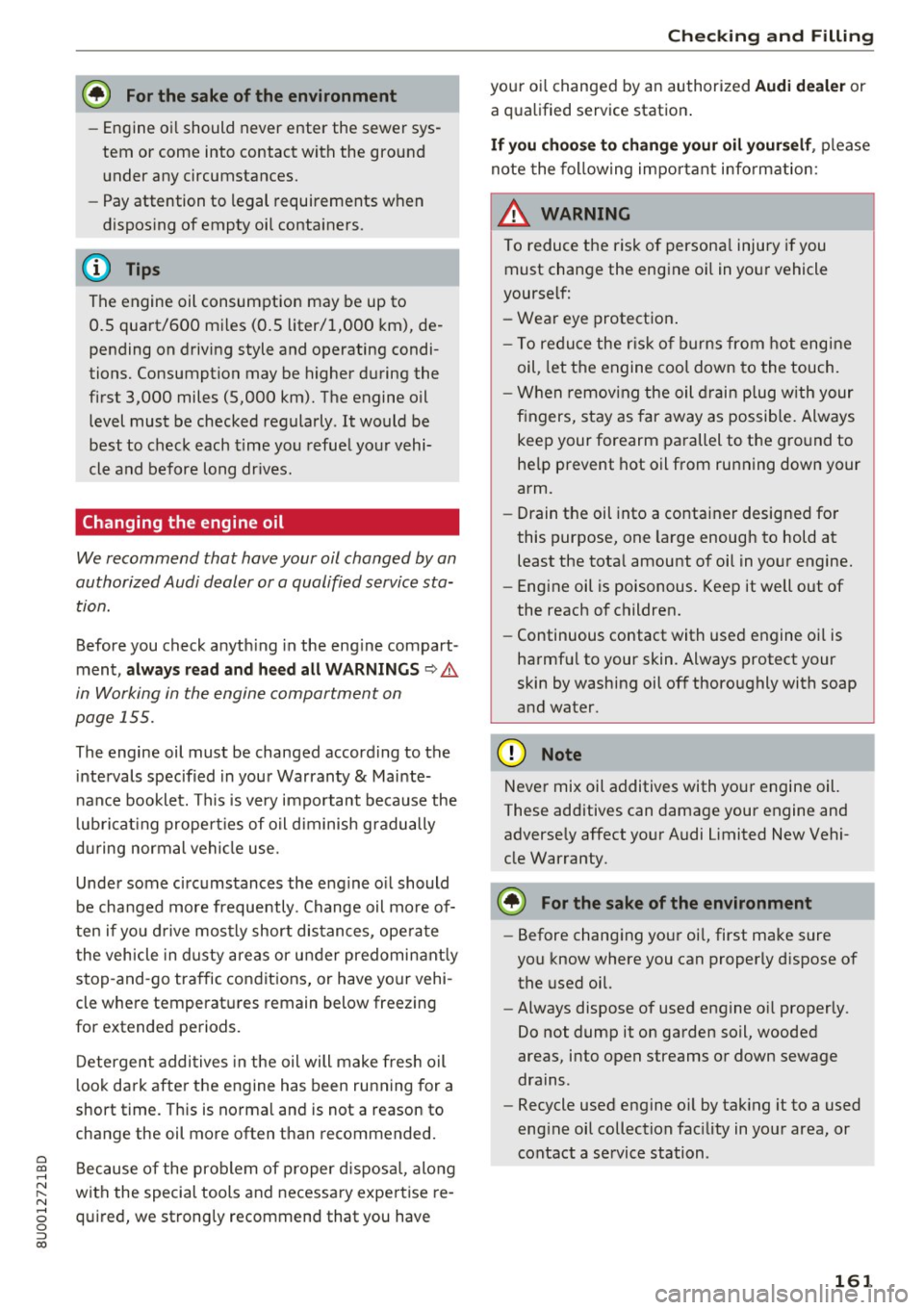
0 co ......
"' ,....
"' ...... 0 0 :::,
00
@ Fo r the sa ke of the env ironment
- Engine oi l should never enter the sewer sys
tem or come into contact with the ground
under any circumstances.
- Pay attention to legal requirements when
disposing of empty oil containers.
The engine oil consumption may be up to 0.5 quart/600 m iles (0.5 liter/1,000 km), de
pending on driving style and operating condi
tions. Consumption may be higher during the
first 3,000 miles (5,000 km). The engine oil
level must be checked regularly . It would be
best to check each time you refuel your vehi
cle and before long dr ives.
Changing the engine oil
We recommend that have your oil changed by an
authorized Audi dealer or a qualified service sta
tion.
Before you check anyth ing in the eng ine compart
ment,
alw ays r ea d and heed all WARNINGS Q .&.
in Working in the engine compartment on
page 155.
The engine oil must be changed according to the
intervals specified in your Warranty
& Mainte
n ance booklet. This is very important because the
l ubri cat ing propert ies of o il diminish gradually
d ur ing normal vehicle use.
Under some c ircumstances the eng ine o il should
be changed more frequently . Change oil more of
ten if yo u drive mostly short distances, ope rate
the vehicle in d usty areas or under predominant ly
stop-and -go traffic conditions, or have your vehi
cle where temperatures remain below freezing
for extended periods.
Detergent additives in the oil will make fresh oil
l ook da rk after the engine has been running for a
short time. This is normal and is not a reason to
change the oil more often than recommended.
Because of the problem of p roper disposal, along
with the special tools and necessa ry expertise re
qu ired, we strong ly recommend that you have
Ch eck ing and Filling
your oi l changed by an authorized Audi dealer or
a qualified service station .
If yo u choo se to ch ange yo ur oil your self, please
note the follow ing important info rmation:
A WARNING
=
To reduce the risk of persona l injury if you
must change the engine oil in your vehicle
yourself:
- Wear eye protect ion .
-
-To redu ce the r is k of burns from hot eng ine
oil, let the engine cool down to the touch.
- W hen remov ing the oil d rain plug w ith your
fingers, stay as far away as possib le. Always
keep your forearm parallel to the ground to
he lp prevent hot oil from running down your
arm.
- Drain the oil into a container designed for
this purpose, one la rge enough to hold at
least the tota l amount of oil in your engine.
- Engine oil is poisonous. Keep it well out of
the reach of children.
- Continuous contact with used engine oil is
harmful to your skin. Always protect your
skin by washing oil off thoroughly with soap
and water.
(D Note
Never mix oil additives with your engine oil.
These additives can damage your engine and
adverse ly affect yo ur Audi Limited New Vehi
cle Warranty.
@ For the sa ke of the environment
- Before chang ing your oi l, first make sure
you know where you can properly d ispose of
the used oil.
- Always dispose of used engine o il properly.
Do not dump it on garden soil, wooded
areas, into open streams or down sewage
drains.
- Recycle used engine o il by tak ing it to a used
eng ine oil collection fac ility in your area, or
contact a service station .
161
Page 164 of 230
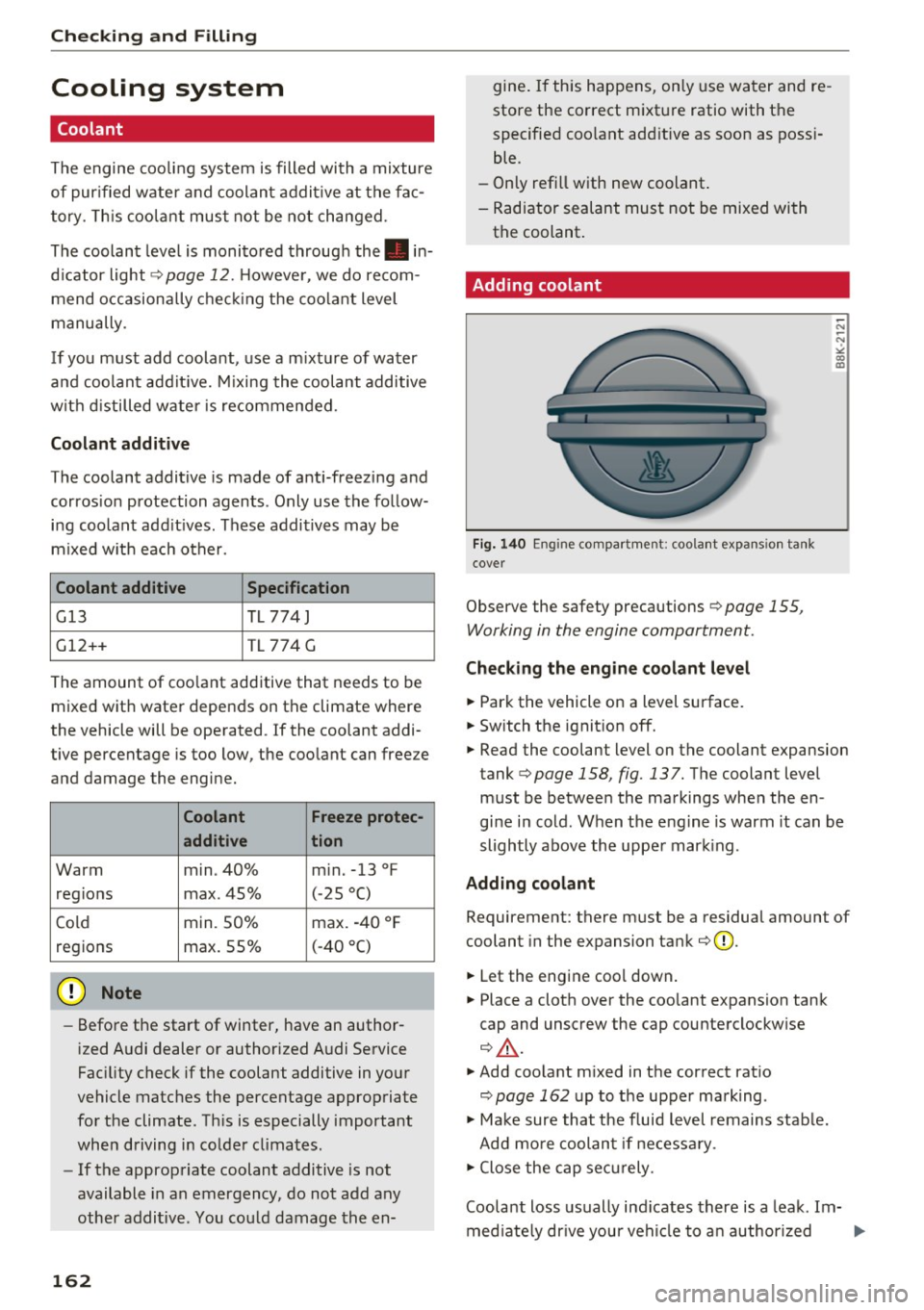
Check ing and F illing
Cooling system
Coolant
The engine coo ling system is filled with a mixture
of pur ified wate r and coolan t addit ive at the fa c
t ory . T his coo la nt must not be not changed .
The coolant leve l is monito red throug h the . in
d icator light
¢ page 12. Howeve r, we do recom
mend occasionally chec king the coo la nt level
manually.
If you must add coolant, use a m ixt ure of wa ter
a nd coo lant add it ive. Mixing the coolant additive
with d istilled water is recommended.
Coolant additive
The coolant additive is made of ant i-freezing and
corros ion protection agents. Only use the fo llow
ing coolant add it ives. These addit ives may be
m ixed w it h each other.
Coolant additive Specification
G13
TL 774 J
G12++ TL 774 G
The amount of coo lant add itive that needs to be
mixed wit h water depends on the climate where
the vehicle will be operated . If the coolant addi
tive percentage is too low, the coolant can free ze
and damage the engine.
Coolant Freeze protec-
additive tion
Warm min . 40% m in. -13 °F
reg ions max . 45% (
- 25 °C)
Co ld min. 50% max. -40 °F
reg ions max. 55% (-40 °C)
CJ) Note
- Befo re the start of winter, have an author
i zed Audi dealer or authorized A udi Service
Fac ility check if the coolant additive in yo ur
vehicle matc hes the percentage approp riate
for the climate . Th is is especially important
whe n driving in co lde r clima tes.
- If the approp riate coolant additive is not
available in an emergency, do no t add any
other addi tive . You cou ld damage the en-
162
gine . If this h appens, on ly use wa ter and re
store the correct m ixt ure ratio with t he
specified coo lant ad ditive as soon as poss i
ble.
- Only refill w ith new coolant .
- Radiator sealant mus t not be mixed wi th
the coolant .
Adding coolant
Fig. 140 En gine co mpar tm ent: coo la nt expans io n ta nk
cove r
Observe the safety precautions¢ page 155,
Working in the engine compartment .
Checking the eng ine c oolant level
.,. Park the vehicle on a level surface .
.,. Sw itch the ignit ion off.
-"' -"' •
"" co a,
.,. Read the coolant level on the coolant expansion
tank ¢
page 158 , fig. 137. T he coolant leve l
must be betwee n the markings when the en
gi ne i n cold . When t he e ng ine is warm it can be
slightly above the uppe r mar king .
Adding coolant
Requirement: there must be a residual amount of
coolant in the expansion ta nk
¢ (D .
.,. Let the engine coo l down.
.,. Place a clot h over the coolant expansion tan k
cap and unscrew the cap counterclockw ise
¢ .&._ .
.,. Add coo lant m ixed in the cor rect rat io
c;, page 162 up to t he up per ma rk ing .
.,. Make sure that the fluid level remains stab le.
Add mo re coolan t if necess ary.
.,. Close the cap sec urely .
Coo lant loss usually ind icates there is a lea k. Im-
med iate ly dr ive you r ve hicl e to a n author ized .,.
Page 165 of 230
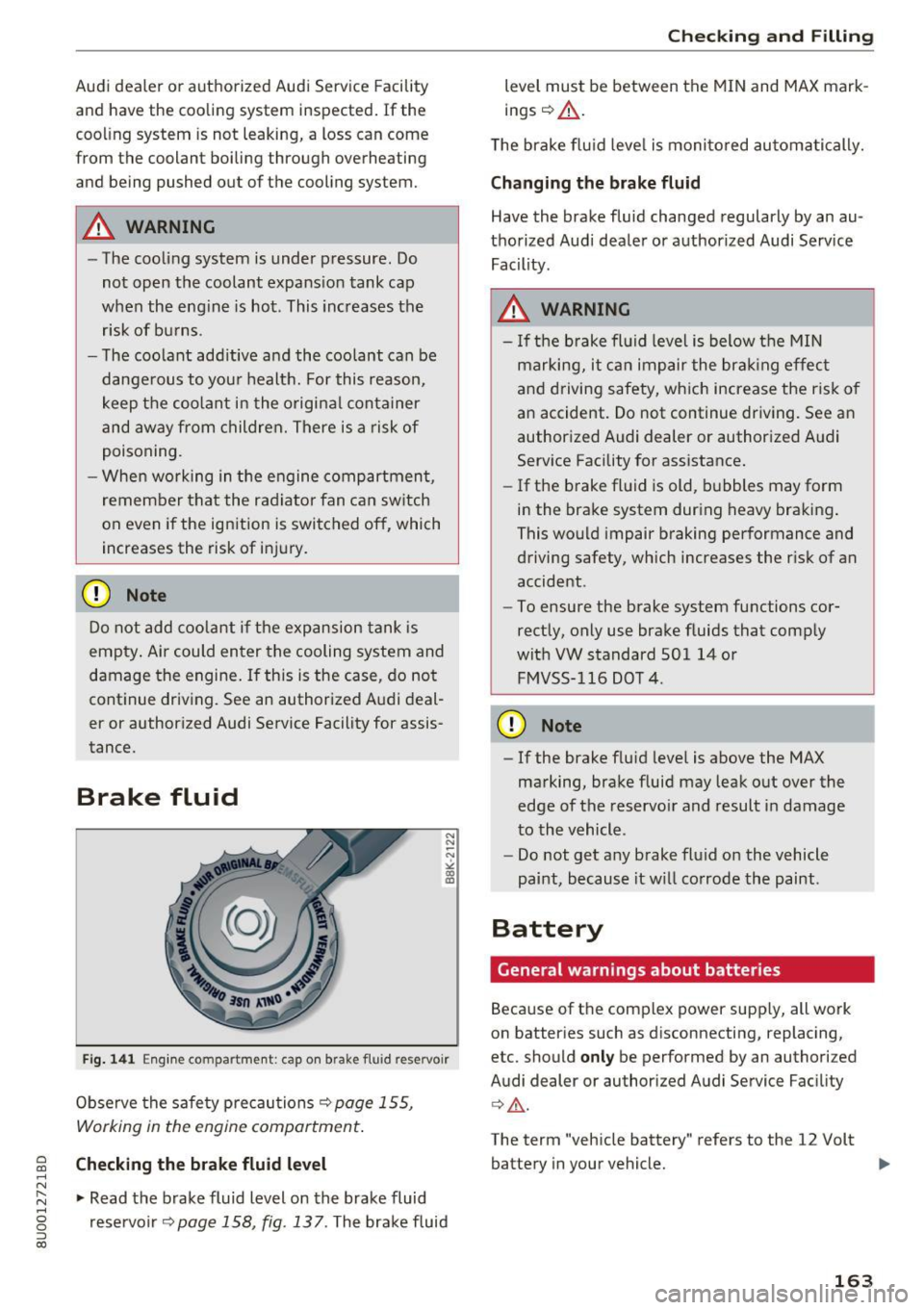
a
co
...... N r-,. N
"" 0 0 ::, co
Audi dealer or authorized Audi Service Facility
and have the cooling system inspected. If the
cooling system is not leaking, a loss can come
from the coolant boiling through overheating
and being pushed out of the cooling system.
A WARNING
- The cooling system is under pressure . Do
not open the coolant expansion tank cap
when the engine is hot . This increases the
risk of burns .
- The coolant additive and the coolant can be
dangerous to your health. For this reason,
keep the coolant in the original container
and away from children. There is a risk of
poisoning.
- When working in the engine compartment,
remember that the radiator fan can switch
on even if the ignition is switched off, which
increases the risk of injury.
CD Note
-
Do not add coolant if the expansion tank is
empty . Air could enter the cooling system and
damage the engine.
If this is the case, do not
continue driving. See an authorized Audi deal
er or authorized Audi Service Facility for assis
tance.
Brake fluid
Fig. 141 Eng ine compartment: cap on brake flu id reservoir
Observe the safety precautions ¢ page 155,
Working in the engine compartment .
Checking the brake fluid level
~ Read the brake fluid Level on the brake fluid
reservoir ~
page 158, fig . 13 7. The brake fluid
Checking and Filling
Level must be between the MIN and MAX mark
ings
~ A .
The brake fluid Level is monitored automatically.
Changing the brake fluid
Have the brake fluid changed regularly by an au
thorized Audi dealer or authorized Audi Service Facility .
A WARNING
- If the brake fluid level is below the MIN
marking, it can impair the braking effect
and driving safety, which increase the risk of
an accident. Do not continue driving. See an
authorized Audi dealer or authorized A udi
Service Facility for assistance.
- If the brake fluid is old, bubbles may form
in the brake system during heavy braking .
This would impair braking performance and driving safety, which increases the risk of an
accident .
- To ensure the brake system functions cor
rectly, only use brake fluids that comply
with VW standard 501 14 or
FMVSS-116 DOT 4.
CD Note
- If the brake flu id level is above the MAX
marking, brake fluid may Leak out over the
edge of the reservoir and result in damage
to the vehicle.
- Do not get any brake fluid on the vehicle
paint, because it will corrode the paint.
Battery
General warnings about batteries
Because of the complex power supp ly, all work
on batteries such as disconnecting, replacing,
etc. should
only be performed by an authorized
Audi dealer or authorized Audi Service Facility
¢ .&,.
The term "vehicle battery " refers to the 12 Volt
battery in your vehicle.
163
...
Page 166 of 230
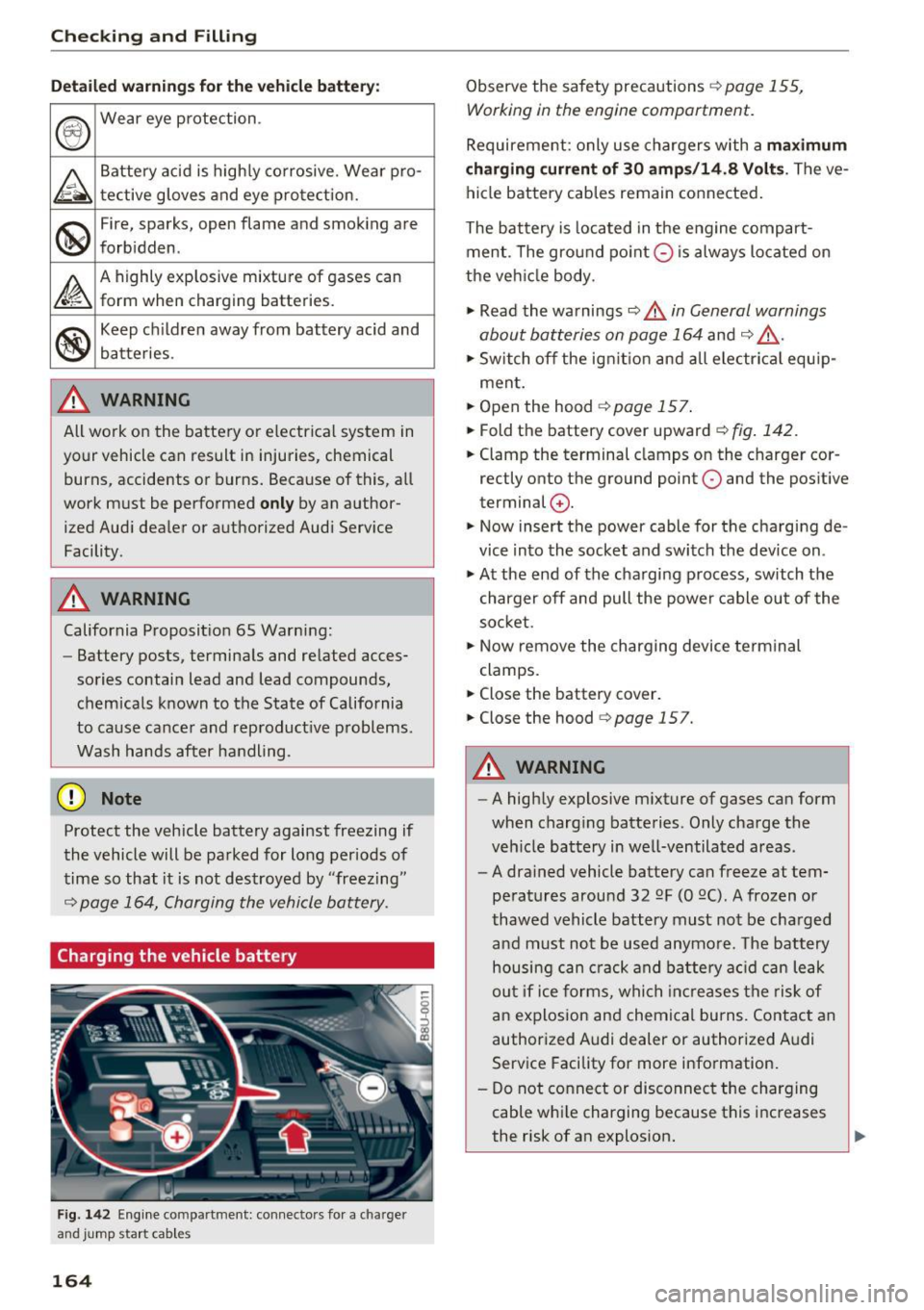
Checking and Filling
Detailed warning s for the vehicle b atter y:
®
Wear eye protection .
A
Battery acid is high ly corrosive . Wear pro-
tective gloves and eye pro tect ion.
@
F ire, spark s, open flame an d smok ing are
forb idden .
~
A highly explosive mix ture of gases can
form when charging batteries.
®
Keep c hildren away from battery acid and
ba tteries .
A WARNING
All work on the battery or electrical system in
your vehicle can result in injuries, chemical
burns, accidents or burns. Because of this, all
work must be performed
onl y by an author
i z ed Aud i dealer or authorized Audi Serv ice
Facility.
A WARNING
California Proposit ion 65 Warning :
- Battery posts, termina ls and related acces
sories contain lead and lead compounds,
chem icals known to the State of California
to cause cancer and reproductive problems .
Wash hands after handling .
(D Note
Protect the vehicle battery against freezing if
the vehicle wilt be parked for long periods of
time so that it is not destroyed by "freezing"
9 page 164, Charging the vehicle battery .
Charging the vehicle battery
Fig . 14 2 Eng ine co mpartment: con nect ors fo r a c har ger
and jump start cab les
164
Observe the safety precautions 9 pag e 155,
Working in the eng ine compartm ent.
Requirement: only use chargers with a maximum
ch arg ing curr ent of 30 amps /14 .8 V olt s.
The ve
hicle battery cables remain connected .
The battery is located in the engine compart
ment . T he ground po int
0 i s always located on
the veh icle body .
.,. Read the wa rnings
9 .&. in General warnings
about batteries on page 164
and 9 ,&. .
.,. Switch off the ig nitio n and all electrica l equ ip-
men t.
.,. Open the hood
9 page 157 .
.,. Fold th e battery cover upward 9 fig. 142.
.,. Clamp the terminal clamps on the charger cor
rectly onto the ground point
O and the pos it ive
termin al(v .
.,. Now insert the power cable for the charging de
vice into the socket and switch the device on .
.,. At the end of the charging p rocess, switch the
charger off and pull the power cable ou t of the
socket.
.,. Now remove the charging device term inal
clamps.
.,. Close the batt ery cov er.
.,. Close the hood
¢ page 15 7.
A WARNING
- A high ly explosive mixture of gases can form
when charg ing batteries . Only charge the
veh icle battery in we ll-ventilated areas .
- A drained vehicle battery can freeze at tem
peratures around 32 QF (0 QC). A frozen or
thawed vehicle battery must not be charged
and must not be used anymo re . T he battery
housing can crack and batte ry a cid can leak
out if ice forms, which increases the risk of
an explosion and chemical burns. Contact an
authorized Audi dealer or authorized Audi
Service Facility for more information.
- Do not connect or disconnect the charging
cable wh ile charging because this increases
the risk of an explosion .